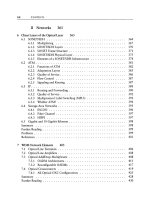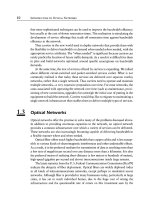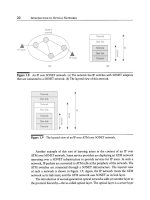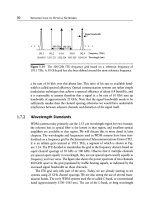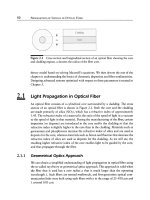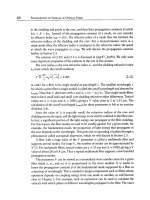Optical Networks: A Practical Perspective - Part 3 pptx
Bạn đang xem bản rút gọn của tài liệu. Xem và tải ngay bản đầy đủ của tài liệu tại đây (386.82 KB, 10 trang )
xx CONTENTS
II Networks
361
6 Client Layers of the Optical Layer 363
6.1 SONET/SDH 364
6.1.1 Multiplexing 367
6.1.2 SONET/SDH Layers 370
6.1.3 SONET Frame Structure 371
6.1.4 SONET/SDH Physical Layer 375
6.1.5 Elements of a SONET/SDH Infrastructure 378
6.2 ATM 381
6.2.1 Functions of ATM 382
6.2.2 Adaptation Layers 385
6.2.3 Quality of Service 386
6.2.4 Flow Control 387
6.2.5 Signaling and Routing 387
6.3 IP 388
6.3.1 Routing and Forwarding 390
6.3.2 Quality of Service 392
6.3.3 Multiprotocol Label Switching (MPLS) 392
6.3.4 Whither ATM? 394
6.4 Storage-Area Networks 395
6.4.1 ESCON 396
6.4.2 Fibre Channel 397
6.4.3 HIPPI 397
6.5 Gigabit and 10-Gigabit Ethernet 398
Summary 398
Further Reading 399
Problems 399
References 401
7 WDM Network Elements 403
7.1 Optical Line Terminals 406
7.2 Optical Line Amplifiers 408
7.3 Optical Add/Drop Multiplexers 408
7.3.1 OADM Architectures 411
7.3.2 Reconfigurable OADMs 417
7.4 Optical Crossconnects 419
7.4.1 All-Optical OXC Configurations 425
Summary 428
Further Reading 430
CONTENTS xxi
Problems 431
References 433
8 WDM Network Design 437
8.1 Cost Trade-Offs: A Detailed Ring Network Example 441
8.2 LTD and RWA Problems 448
8.2.1 Lightpath Topology Design 449
8.2.2 Routing and Wavelength Assignment 454
8.2.3 Wavelength Conversion 457
8.2.4 Relationship to Graph Coloring 461
8.3 Dimensioning Wavelength-Routing Networks 462
8.4 Statistical Dimensioning Models 464
8.4.1 First-Passage Model 466
8.4.2 Blocking Model 467
8.5 Maximum Load Dimensioning Models 475
8.5.1 Offline Lightpath Requests 475
8.5.2 Online RWA in Rings 481
Summary 482
Further Reading 484
Problems 484
References 488
9 Control and Management 495
9.1 Network Management Functions 495
9.1.1 Management Framework 497
9.1.2 Information Model 499
9.1.3 Management Protocols 500
9.2 Optical Layer Services and Interfacing 502
9.3 Layers within the Optical Layer 504
9.4 Multivendor Interoperability 505
9.5 Performance and Fault Management 507
9.5.1 The Impact of Transparency 508
9.5.2 BER Measurement 509
9.5.3 Optical Trace 509
9.5.4 Alarm Management 510
9.5.5 Data Communication Network (DCN) and Signaling 512
9.5.6 Policing 513
9.5.7 Optical Layer Overhead 514
9.6 Configuration Management 519
9.6.1 Equipment Management 519
xxii CONTENTS
9.6.2 Connection Management 520
9.6.3 Adaptation Management 524
9.7 Optical Safety 526
9.7.1 Open Fiber Control Protocol 528
Summary 530
Further Reading 531
Problems 532
References 534
10 Network Survivability 537
10.1 Basic Concepts 539
10.2 Protection in SONET/SDH 542
10.2.1 Point-to-Point Links 544
10.2.2 Self-Healing Rings 546
10.2.3 Unidirectional Path-Switched Rings 549
10.2.4 Bidirectional Line-Switched Rings 550
10.2.5 Ring Interconnection and Dual Homing 555
10.3 Protection in IP Networks 558
10.4 Why Optical Layer Protection 560
10.4.1 Service Classes Based on Protection 566
10.5 Optical Layer Protection Schemes 567
10.5.1 1 + 10MS Protection 570
10.5.2 1:10MS Protection 571
10.5.30MS-DPRing 571
10.5.40MS-SPRing 571
10.5.5 I:N Transponder Protection 573
10.5.6 1 + 10Ch Dedicated Protection 574
10.5.70Ch-SPRing 575
10.5.80Ch-Mesh Protection 576
10.5.9 Choice of Protection Technique 582
10.6 Interworking between Layers 582
Summary 583
Further Reading 584
Problems 584
References 587
11 Access Networks 591
11.1 Network Architecture Overview 593
11.2 Enhanced HFC 598
11.3 Fiber to the Curb (FTTC) 599
11.3.1 PON Evolution 609
CONTENTS xxiii
Summary 610
Further Reading 611
Problems 611
References 612
12 Photonic Packet Switching 615
12.1 Optical Time Division Multiplexing 619
12.1.1 Bit Interleaving 620
12.1.2 Packet Interleaving 623
12.1.3 Optical AND Gates 625
12.2 Synchronization 631
12.2.1 Tunable Delays 632
12.2.2 Optical Phase Lock Loop 633
12.3 Header Processing 634
12.4 Buffering 635
12.4.1 Output Buffering 637
12.4.2 Input Buffering
639
12.4.3 Recirculation Buffering 639
12.4.4 Using Wavelengths for Contention Resolution 641
12.4.5 Deflection Routing 645
12.5 Burst Switching 649
12.6 Testbeds 650
12.6.1 KEOPS 650
12.6.2 NTT's Optical ATM Switches 652
12.6.3 BT Labs Testbeds 654
12.6.4 Princeton University Testbed 654
12.6.5 AON 655
12.6.6 CORD 656
Summary 657
Further Reading 658
Problems 659
References 660
13 Deployment Considerations 667
13.1 The Evolving Telecommunications Network 667
13.1.1 The SONET/SDH Core Network 669
13.1.2 Architectural Choices for Next-Generation Transport Networks 673
13.2 Designing the Transmission Layer 681
13.2.1 Using SDM 682
13.2.2 Using TDM 683
13.2.3 Using WDM 684
xxiv CONVENTS
13.2.4 Unidirectional versus Bidirectional WDM Systems 686
13.2.5 Long-Haul Networks 688
13.2.6 Long-Haul Network Case Study 689
13.2.7 Long-Haul Undersea Networks 697
13.2.8 Metro Networks 698
13.2.9 Metro Ring Case Study 700
13.2.10 From Opaque Links to Agile All-Optical Networks 704
Summary 705
Further Reading 706
Problems 706
References 710
A Acronyms 711
B Symbols and Parameters 717
C Standards 721
C.1 International Telecommunications Union (ITU-T) 721
C.1.1 Fiber 721
C.1.2 SDH (Synchronous Digital Hierarchy) 721
C.1.3 Optical Networking 722
C.1.4 Management 722
C.2 Telcordia 723
C.2.1 Physical and Environmental 723
C.2.2 SONET 723
C.2.3 Optical Networking 724
C.3 American National Standards Institute (ANSI) 724
C.3.1 SONET 724
C.3.2 ESCON and Fibre Channel 724
D Wave Equations
727
E Pulse Propagation in Optical Fiber 731
E.1 Propagation of Chirped Gaussian Pulses 734
E.2 Nonlinear Effects on Pulse Propagation 735
E.3 Soliton Pulse Propagation 738
Further Reading 739
References 739
F Nonlinear Polarization 741
CONTENTS XXV
G Multilayer Thin-Film Filters 743
G.1 Wave Propagation at Dielectric Interfaces 743
G.2 Filter Design 747
References 750
H Random Variables and Processes 751
H.1 Random Variables 751
H.1.1 Gaussian Distribution 752
H. 1.2 Maxwell Distribution 753
H.1.3 Poisson Distribution 753
H.2 Random Processes 754
H.2.1 Poisson Random Process 755
H.2.2 Gaussian Random Process 756
Further Reading 756
References 756
I Receiver Noise Statistics 757
1.1 Shot Noise 759
1.2 Amplifier Noise 760
References 762
Bibliography 763
Index 797
This Page Intentionally Left Blank
Preface
Since the first edition of this book appeared in February
1998,
we have witnessed a
dramatic explosion in optical networking. Optical networking used to be confined
to a fairly small community of researchers and engineers but is now of great interest
to a broad audience including students; engineers in optical component, equipment,
and service provider companies; network planners; investors; venture capitalists; and
industry and investment analysts.
With the rapid pace in technological advances and the widespread deployment of
optical networks over the past three years, the need for a second edition of this book
became apparent. In this edition we have attempted to include the latest advances in
optical networks and their underlying technologies. We have also tried to make the
book more accessible to a broader community of people interested in learning about
optical networking. With this in mind, we have rewritten several chapters, added a
large amount of new material, and removed some material that is not as relevant to
practical optical networks. We have also updated the references and added some new
problems.
The major changes we've made are as follows: We have mostly rewritten the
introduction to reflect the current understanding of optical networks, and we've
added a section called "Transmission Basics" to introduce several terms commonly
used in optical networking and wavelength division multiplexing (WDM) to the
layperson.
In Chapter 2, we've added significant sections on dispersion management and
solitons, along with a section describing the different fiber types now available.
xxvii
xxviii
PREFACE
In Chapter 3, we now cover electro-absorption modulated lasers, tunable lasers,
Raman amplifiers, and L-band erbium-doped fiber amplifiers, and we have signifi-
cantly expanded the section on optical switching to include the new types of switches
using micro-electro-mechanical systems (MEMS) and other technologies.
In Chapter 4, we cover return-to-zero modulation and other newer modulation
formats such as duobinary, as well as forward error correction, now widely used
in high-bit-rate systems. Chapter 5 now includes expanded coverage of chromatic
dispersion and polarization effects, which are important factors influencing the design
of high-bit-rate long-haul systems.
The networking chapters of the book have been completely rewritten and ex-
panded to reflect the significant progress made in this area. We have organized these
chapters as follows: Chapter 6 now includes expanded coverage of SONET/SDH,
ATM, and IP networks. Chapter 7 is devoted to architectural considerations under-
lying WDM network elements. Chapter 8 attempts to provide a unified view of the
problems associated with network design and routing in optical networks. Chap-
ter 9 provides significantly expanded coverage of network management and control.
We have devoted Chapter 10 to network survivability, with a detailed discussion on
optical layer protection. Chapter 11 covers access networks with a focus on emerging
passive optical networks (PONs). Chapter 12 provides updated coverage of optical
packet-switched networks. Finally, Chapter 13 focuses on deployment considerations
and is intended to provide the reader with a broad understanding of how telecommu-
nications networks are evolving. It includes a couple of detailed network planning
case studies on a typical long-haul and metro network.
There is currently a great deal of standards activity in this field. We've added an
appendix listing the relevant standards. We have also added another appendix listing
the acronyms used in the book and moved some of the more advanced material on
pulse propagation into an appendix.
While we have mostly added new material, we have also removed some chapters
present in the first edition. We have eliminated the chapter on broadcast-and-select
networks, as these networks are mostly of academic interest today. Likewise, we
also removed the chapter describing optical networking testbeds as they are mostly
of historical importance at this point. Interested readers can obtain a copy of these
chapters on the Internet at
www.mkp.com/opticalnet2.
Teaching and Learning from This Book
This book can be used as a textbook for graduate courses in electrical engineering
or computer science. Much of the material in this book has been covered in courses
taught by us. Chapters 2-5 cover components and transmission technology aspects
of optical networking, and Chapters 6-13 deal with the networking aspects. To
PREFACE xxix
understand the networking issues, students will require a basic undergraduate-level
knowledge of communication networks. We have tried to make the transmission-
related chapters of the book accessible to networking professionals. For example,
components are treated first in a simple qualitative manner from the viewpoint of a
network designer, but their principle of operation is then explained in detail. Some
prior knowledge of semiconductors and electromagnetics will be helpful in appreci-
ating the detailed treatment in some of the sections.
Readers wishing to obtain a broad understanding of the major aspects of optical
networking can read Chapters 1, 6, 7, and 13. Those interested in getting a basic
appreciation of the underlying components and transmission technologies can read
through Chapters 1-5, skipping the quantitative sections.
The book can be the basis for a graduate course in an electrical engineering or
computer science curriculum. A networks-oriented course might emphasize network
architectures and control and management, by focusing on Chapters 6-13, and skim
over the technology portions of the book. Likewise, a course on optical transmission
in an electrical engineering department might instead focus on Chapters 2-5 and
omit the remaining chapters. Each chapter is accompanied by a number of prob-
lems, and instructors may obtain a solution manual by contacting the publisher at
Acknowledgments
We were fortunate to have an outstanding set of reviewers who made a signifi-
cant effort in reading through the chapters in detail and providing us with many
suggestions to improve the coverage and presentation of material. They have been
invaluable in shaping this edition. Specifically, we would like to thank Paul Green,
Goff Hill, David Hunter, Rao Lingampalli, Alan McGuire, Shawn O'Donnell, Walter
Johnstone, Alan Repech, George Stewart, Suresh Subramaniam, Eric Verillow, and
Martin Zirngibl. In addition, we would like to acknowledge Bijan Raahemi, Jim Refi,
Krishna Thyagarajan, and Mark R. Wilson who provided inputs and comments on
specific topics and pointed out some mistakes in the first edition. Mark R. Wilson
was kind enough to provide us with several applications-oriented problems from
his class, which we have included in this edition. We would also like to thank Amit
Agarwal, Shyam Iyer, Ashutosh Kulshreshtha, and Sarath Kumar for the use of their
mesh network design tool, Ashutosh Kulshreshtha for also computing the detailed
mesh network design example, Tapan Kumar Nayak for computing the lightpath
topology design example, Parthasarathi Palai for simulating the EDFA gain curves,
and Rajeev Roy for verifying some of our results. As always, we take responsibility
for any errors or omissions and would greatly appreciate hearing from you as you
discover them. Please email your comments to



